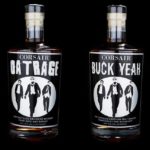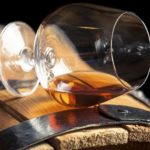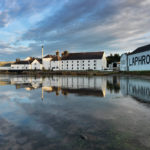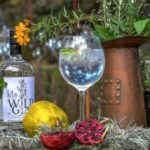Meet Aquavit, a Flavorful Spirit No Longer Bound to Europe
Walk into most bars in the United States and the number of aquavits on the shelf will likely be zero or one. Perhaps there’s a bottle of Norwegian Linie or American Krogstad, or a dusty bottle of the no longer imported Aalborg, if the establishment doesn’t pour it often. Outside of explicitly Scandinavian places, the American attitude toward aquavit seems to be that having one option is plenty sufficient. But these bars are missing out. Though aquavit remains largely an esoteric spirit, it’s also one of the most diverse, and it’s enjoying a mini-renaissance among domestic craft distillers and importers.
Much like gin, aquavit is defined in United States regulations by its primary botanical. While gin’s star is juniper, with aquavit, it’s caraway.
Aquavit, a neutral spirit usually distilled from grain and flavored with botanicals, has been produced in Scandinavia for centuries. Much like gin, aquavit is defined in United States regulations by its primary botanical. While gin’s star is juniper, with aquavit, it’s caraway. To create unique expressions of the spirit, distillers often complement caraway with a myriad of spices and botanicals such as dill, cumin, coriander, juniper, fennel, anise, and citrus. Caraway notes are predominant in some brands, such as Brennivin, while in others these various botanicals sometimes take center stage.
It’s a common misperception that aquavit is an anise-flavored spirit and one could argue that anise-forward aquavits are becoming a signature Pacific Northwest style, likely reflecting the influence of House Spirits’ popular Krogstad aquavit. Other aquavits from the region that also feature the flavor prominently include Sound Spirits’ Blekksprut, Old Ballard Liquor Company’s Nymodig, and Bull Run’s Regnig Dag. But many aquavits, in contrast, include no anise notes whatsoever.
Like many other spirits, aquavits vary in their ages. While most aquavit in the United States is sold unaged, a few brands, like Linie or Riktig, are aged on wood such as oak or alder for a few months or years, though some Nordic brands age up to 20 years. Much like aging a whiskey or brandy, this time on wood both adds flavors and smooths out the spirit’s rough edges.
Unaged aquavit is best served chilled, with the bottle pulled straight from the freezer or, for a more striking presentation, literally frozen into a block of ice. Although, some drinkers may prefer to sip aged aquavits at room temperature to capture the most nuanced flavors.
In liquor stores and on bar menus, aquavit is often haphazardly listed among the sweet liqueurs, an indication of how poorly understood aquavit is in the United States. According to Nick Duble, bartender at mrnilsson, a Scandinavian pop-up in New York, “Usually if a restaurant has aquavit at all, they don’t have more than one … it just ends up in that section of the menu because there isn’t any other category for it.” Aquavit is a dry spirit, so clumping it amongst liqueurs make no sense. It warrants its own listing, perhaps in proximity to the gin or vodka section.
In Scandinavia, the traditional way to drink aquavit is socially with food and friends, poured into small shot glasses and taken in one swig with a toast of “skoal!” But in the United States, aquavit is most often mixed into cocktails. Given its similarities to gin, bartenders sometimes substitute it into classic gin drinks like the Martini, Negroni, Collins, or French 75. Yet aquavit’s savory notes can also play well in other contexts; it’s not uncommon to see it offered in a Bloody Mary with delicious results. It also does well in spirit-forward drinks such as David Wondrich’s Old Bay Ridge cocktail, a riff on the Old Fashioned that splits the base spirit with equal parts aquavit and rye whiskey.
A few years ago, most of the aquavit available on the American market was imported from Norway, Sweden and Denmark. Imports gradually tapered off as producers focused on the European market, and what we receive here is a mere shadow of the bounty available in Scandinavia. For an idea of what American drinkers are missing, scan through the spirits menu at Øl & Brød, the ambitious Copenhangen bar and restaurant run by the famed Mikkeller beer company. Dozens of aquavits grace their list, including vintage releases dating back to 1982.
Though American imports have declined, new offerings from small domestic distillers have appeared in increasing numbers, often as a side project and sometimes as the core of their business. Like gin or vodka, aquavit offers economic advantages to producers since it can be sold unaged and can be made from a base of neutral spirits. As more Americans discover aquavit, the number of brands available will likely continue to grow.
Below, a guide to ten aquavits that showcase the diversity of the spirit, all currently on the American market. Some are widely available, while others will take some hunting to track down. Regardless, they’re all worthy of a spot on the back bar.
10 Great Aquavits to Try
Lysholm Linie ($38)
Oslo, Norway
Until recently, Linie was the last Scandinavian aquavit with broad American distribution. This mellow Norwegian distillate has a famously unique production process in which it is stored in sherry casks and aged at sea as it travels from Norway to Australia and back, crossing the equatorial line (or “Linie”) twice. Pro tip: Peek inside the bottle to the reverse side of the label to find out exactly when your batch traveled the seas.Brennivin ($33)
Borgarnes, Iceland
The newest imported aquavit on the market has the distinction of being Foo Fighters frontman Dave Grohl’s favorite. Affectionately known as the “Black Death” due to its stark black label and its impact on those unaccustomed to taking schnapps, it’s nothing to be afraid of. In fact, it’s an aquavit with a crisp, straightforward caraway flavor. Now that it’s finally available in the United States, expect to find Brennivin at hip bars across the country. Keep an eye out as well for their extremely limited Christmas aquavit aged in sherry and bourbon casks, which will be exported to the United States for the first time in late 2015.Gamle Ode ($30)
New Richmond, Wisconsin
Mike McCarron, the owner of Gamle Ode, fell in love with aquavit on trips to Iceland working as a skiing coach. Unable to find the aquavits he loved in the United States, he decided to make his own. The result is a line of three aquavits distilled in Wisconsin by 45th Parallel. Celebration aquavit is his take on traditional Danish snaps with caraway, dill, juniper, coriander, vanilla, star anise, and citrus peel, aged in a blend of wine and bourbon barrels. The annual Holiday release combines traditional botanicals with orange peel, mint, and allspice, and is aged in wine barrels. Both are wonderfully complex, but it’s his flagship Dill aquavit that steals the show, with a clean, unmistakable dill aroma. It’s unlike any other spirit on the market, and is one of the best aquavits available in the United States.Gamle Ode ($30)
New Richmond, Wisconsin
Mike McCarron, the owner of Gamle Ode, fell in love with aquavit on trips to Iceland working as a skiing coach. Unable to find the aquavits he loved in the United States, he decided to make his own. The result is a line of three aquavits distilled in Wisconsin by 45th Parallel. Celebration aquavit is his take on traditional Danish snaps with caraway, dill, juniper, coriander, vanilla, star anise, and citrus peel, aged in a blend of wine and bourbon barrels. The annual Holiday release combines traditional botanicals with orange peel, mint, and allspice, and is aged in wine barrels. Both are wonderfully complex, but it’s his flagship Dill aquavit that steals the show, with a clean, unmistakable dill aroma. It’s unlike any other spirit on the market, and is one of the best aquavits available in the United States.Old Ballard ($24)
Seattle, Washington
No domestic producer makes more aquavits than Old Ballard Liquor Company. Setting up shop in the heart of Seattle’s Scandinavian neighborhood of Ballard, this distiller offers a rotating selection of seasonal aquavits alongside other staple spirits. At the core is Riktig, a caraway-forward aquavit aged with alder wood. Midsommar dill and Alskar citrus round out the main line; the rare Ragnarok weighs in at 120 proof, and the Skogen flavored with fresh spruce tips arrives in June. Old Ballard’s aquavits are often distinguished by a two-step process in which a distilled, clear spirit flavored with caraway, known as a “taffel” aquavit, is then infused with additional botanicals.Solståndet ($43)
Near Reykjavik, Iceland
One of the regrettable trends in liquor marketing is the tendency to blend two unrelated yet popular spirits, resulting in combinations that mix tequila or cognac with equally marketable vodka. Solståndet takes the opposite approach: it’s a mash-up of two very hard to market spirits, aquavit and genever. This “maltat akvavit” marries the malty backbone of genever with a spring-inspired aquavit carrying distinct notes of dill and lemon. Oh, and the first imports were distilled in France, not Scandinavia, though production is shifting to Iceland. A strange spirit? Yes, but also a strangely alluring one.Krogstad ($24)
Portland, Oregon
Distilled by House Spirits and named after co-founder Christian Krogstad, this is the first aquavit that many American drinkers have tried. Now offered in two expressions, the unaged Festlig and aged Gamle, these are the most anise-forward of the aquavits sold in the US. They play very well in cocktails that benefit from using a dry anise spirit.Ole Bjørkevoll ($35)
Portland, Oregon
One of the first products from Portland, Oregon’s new Rolling River distillery is Ole Bjørkevoll, named after a Scandinavian fisherman who emigrated to the Pacific Northwest in 1924. What it lacks in easy pronunciation it makes up for with a delicious botanical blend of dill seed, fresh dill, caraway, fennel, and juniper. It’s lighter than many American aquavits, making it very drinkable yet still complex. Rolling River has several additional aquavits planned for release in the coming year, promising to make them one of the most interesting aquavit producers in the United States.North Shore ($28)
Chicago, Illinois
At 90 proof and packing a powerful hit of cumin, the Private Reserve aquavit from Chicago’s North Shore distillery possesses a spicy kick. This is mellowed a bit by aging in new American oak, but it’s still an assertive sipper. With its strong botanical note, it makes an excellent substitute for gin in a Negroni.Skadi ($50)
Missoula, Montana
One of the best aquavits for sipping cold and straight comes from the Montgomery Distillery in Missoula, Montana. Distilled from wheat with caraway, bog myrtle, lemon peel, and other botanicals, it has an approachable flavor profile that wins over aquavit enthusiasts and skeptics alike.Temperance Regnig Dag ($30)
Portland, Oregon
Translated as “rainy day,” Bull Run’s Regnig Dag aquavit is aptly named for its annual December release in Portland, Oregon. It’s flavored with caraway, coriander, and fennel, all of which are present on the palate without any one spice landing out of balance. Complex and smooth thanks to a year of aging in wine barrels, it’s of the best aquavits for sipping neat without chilling, and also works beautifully in cocktails.



















